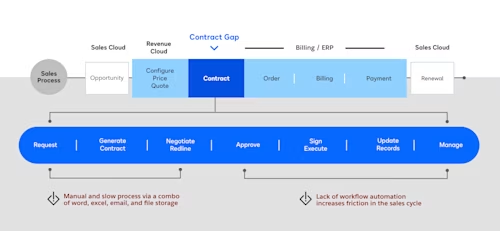
Accelerate Quote-to-Cash and Revenue Recognition with Docusign CLM and Salesforce
By combining contract lifecycle management with the power of Salesforce, sales teams can unify agreement workflows and sales data across the entire QTC process.

For sales teams everywhere, the speed and efficiency of the quote-to-cash (QTC) journey often makes the difference between a customer acquisition and a missed opportunity. But streamlining the end-to-end revenue cycle can become more challenging as businesses and SKUs grow—and stand alone tools can trigger pricing inconsistencies and leave revenue on the table.
The data and documents acquired at each stage of quote-to-cash process inform downstream decision-making. Prices drawn up in the quoting phase are integral for order contracts and even billing forms down the line. Without an integrated system for managing sales data and agreements throughout the quote-to-cash (QTC) process, prices listed in invoices or ERPs can conflict with those in quotes or even contracts (the legal record of sales agreements), sparking billing disputes, slowing sales and damaging client relationships.

An accurate, cohesive quote-to-cash process requires a holistic approach that integrates sales data and agreements from the CPQ, contracting and billing phases with every downstream stage and business tool. Most sales teams recognize Salesforce as integral to any sales process. By combining a contract lifecycle management (CLM) solution with the power of Salesforce, sales teams can unify agreement workflows and sales data across the entire QTC process—supporting sales and your business’s growth.
Consequences of a slow, decentralized quote-to-cash process
Throughout the QTC journey, sales teams create, exchange and amend documents—MSAs, sales contracts, SOWs, purchase orders and more. With just a few products, and therefore limited bundlings and discounts, companies may get by with scattered systems for data management, pricing or contract generation. But as businesses scale, their price books include thousands of SKUs and product bundles, and new discounting approvals—triggering a slew of downstream consequences:
Slowed efficiency affecting pricing, quoting and contract generation
Increased errors in sales documents
Greater risk from rogue terms, conditions and obligations.
With an expanding range of SKUs, automating the CPQ process and integrating these tasks with contracting is crucial. A manual CPQ process lacks high-quality, repeatable, error-free workflows. This makes it nearly impossible for sales teams to understand and appropriately apply thousands of pricing options, discounts and special term language to a booming range of offerings. Though CPQ tools can help with tasks like quoting and billing, these lack integration with subsequent phases like contracting, thereby increasing discrepancies between documents and introducing pricing mistakes. Without a unified source of truth, organizations can trigger legal and compliance ramifications when bills don’t match legally-agreed contract prices. In the end, both your customers and employees suffer from this lack of coordination:
Necessitating revisions. Revising incorrect quotes, contracts, order forms and invoices lengthens the sales cycle and frustrates customers and sales teams alike.
Adding time. Energy is diverted from being productive and is instead spent on sales support, finance, legal and more to sort out errors and answer customer questions
Increasing instances of inaccurate billing. Overcharging customers causes annoyance or even anger, while underpricing products lowers sales commissions, undermines sales team retention and ultimately impacts overall company revenue.
Missing sales quotas. When contracts aren’t signed on-time, the impact on your sales teams’ compensation and reviews—and your bottom line—can be substantial.
Four benefits of integrating your CLM tool with Salesforce Revenue Cloud
1. Accelerate time to revenue
The faster your sales teams can draw up and deliver sales quotes and contracts for signatures, the faster they can receive commissions, add to your company’s revenue and move on to new prospects. Integrating your CLM tool with Salesforce fast tracks the time to revenue by creating one, unified agreement process, from generation to delivery.
With a few clicks, employees can create quotes, sales contracts and SOWs from pre-approved templates, send them to multiple stakeholders and track signing statuses. To shorten signing times even more, they can automate contract reminders and share agreements through Slack. A unified, digital agreement process preserves original product values, pricing SKUs and other data from previous documents in the QTC process so sales teams can quickly pull together contracts and focus on selling, not paperwork.
2. Standardize and automate the process
With a manual QTC process, sales workflows can look different every time, and employees can make decisions independently, exposing businesses to rogue contracting risk. This places a large burden on the document review process to ensure agreements are correct and consistent. In contrast, an integrated QTC experience combining a CLM solution and Salesforce standardizes and automates sales, so management can be assured that the same agreed-upon process and pricing happens each time.
Automation simplifies and unifies QTC, lightening the burden on sales teams and making it easier to take on more complex contracts. Instead of having to get someone in the back office or legal to review all agreements, sales professionals can build contracts based on templates and clauses pre-approved by your company’s legal team. By automating contract creation and delivery, an integrated QTC process helps teams ensure that the right people get the right work at the right time.
3. Reduce contract and billing errors
When data is scattered in different locations, sales teams can easily lose track of previous QTC stages—leading to discrepancies between quoted prices and final contract prices. Using a CLM tool integrated with Salesforce, sales teams can ensure documents only reference validated data from earlier in the QTC journey. To avoid re-keying errors and inconsistencies between prices in quotes, sales contracts and billing systems or ERPs, a CLM solution auto-populates data fields with data pulled straight from Salesforce.
Having one source of truth for contract clauses, price agreements and other sales data limits legal risks and customer billing disputes—allowing for easy references to CPQ data to verify billing numbers.
4. Improve the employee experience
Sales teams are the engine behind the QTC process—generating new growth, exciting opportunities and bolstering the bottom line. As such, they should be free to pursue strategic goals like expanding their client base—not performing manual tasks. A CLM and Salesforce integration lets sales teams do what they do best by creating a self-service experience for sales and enabling them to stay in the spaces where they work—such as Slack.
When revising agreements, sales teams can access legally-approved document edits so they can make simple changes themselves while legal focuses on big-picture, high-value contract matters. Access to a library of pre-approved contract templates and clauses also means sales and legal teams can limit time spent on simple agreements—and devote more energy to high-level (and high-margin) objectives.
The impact of an integrated sales processes: Real-world results
Using a fully-integrated CLM solution like the Docusign CLM integration with Salesforce, sales teams can speed up the sales lifecycle (and hence time to revenue and sales commissions) and ensure the correct data arrives at every stage.
Today, organizations are already seeing the powerful results of a unified QTC process through Docusign CLM for Salesforce. In the case of NCR, the world’s leader in POS and ATM solutions, the lack of a standardized contract process was holding the business back from realizing its potential.
After implementing Docusign CLM for Salesforce, employees can now draft MSAs, sales contracts and SOWs simply by selecting a pre-approved template, automatically populating it with validated Salesforce data and sending it for approval. With the integrated QTC process, the company experienced a significant reduction in errors and an increase in visibility. These changes helped NCR realize an 86 percent decrease in contract execution times and reduced contract process times from three weeks to three days.
For Flexential, a leading provider of IT infrastructure services, the results are equally compelling. Flexential’s native quoting system and third-party contract management software left the company struggling with complex quotes and slow negotiations in the midst of a complex merger.
Amid the chaos, the Docusign CLM and Salesforce integration created a cohesive digital agreement process from the merging companies' workflows. Today, sales employees can quickly update sales agreements within Salesforce during negotiations and then automate the delivery of revised contracts for approval and redlining. With this integration, the company simplified the complexities of handling intricate contracts, and reduced manual transactions by 75 percent and QTC time by 80 percent.
Fast-forward the quote-to-cash journey using Docusign CLM and Salesforce
The quote-to-cash (QTC) journey is the heart of a company’s growth. When businesses implement disjointed data and agreement management, the result not only promotes contract errors—it also increases sales and legal workloads and holds your business back from meeting its revenue potential. The Docusign CLM integration with Salesforce provides an integrated hub for all of your sales data and contract workflows. The CLM suite works with the entire Salesforce Revenue Cloud and Sales Cloud—standardizing processes, connecting your sales data to downstream tasks and accelerating the QTC cycle. Our integrated CLM tool sets sales teams up to thrive as they unlock new prospects.
With an easy-to-implement digital transformation, the Docusign CLM and Salesforce integration empowers businesses to increase their sales volume and handle more complex agreements. Docusign was named a Leader in the 2022 Gartner Magic Quadrant for CLM.
Learn more about the powerful capabilities of the Docusign CLM and Salesforce integration today.
Prachi Mishra is a Director of Product Marketing at Docusign.
Related posts
Docusign IAM is the agreement platform your business needs


